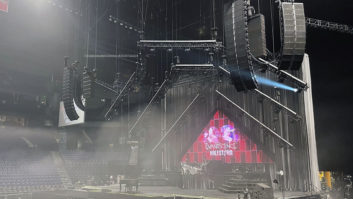There is no shortage of published and anecdotal advice on the most effective way to array loudspeakers. More or less useful, but often biased, information is also available from every speaker manufacturer or major rental company. For example, whole speaker lines are given names leading you to believe that their manufacturer alone holds the secret of arrayability. But in the real world, the keys to arrayability are more complex. Even the best-designed speaker system must be properly implemented. An array may perform perfectly, but it may be the wrong type of array for the application.
Success in designing and installing an array depends on the following: 1) Selecting the best type of array for the specific application’s coverage and power requirements. 2) The relationship between the individual array element coverage angle and the splay angle between the elements. 3) Electronic control of the system elements. 4) Practical matters, such as how and where the speakers can be hung.
This two-part article is intended to cover these four points and should help users develop more effective array techniques in daily practice.
SEVEN ARRAY TYPESWhen most people hear the word “array,” they visualize a multilevel cluster of speakers made up of individual enclosures in horizontal and/or vertical rows. This style, the point-source array, however, is just one of the seven possible types of arrays.
An array of speakers is a combination of multiple speaker enclosures intended to produce a combined response that is distinct from that of the individual units. The combined array will be more powerful, have wider coverage, and, in some cases, narrower coverage than the individual elements. The most obvious example is the wide point source array where a second speaker is added with the goal of expanding the coverage angle. But there are many combinations: specifically, four coupled configurations (speakers close together) and three distributed configurations (speakers spread apart).
If we take two or more speakers and place them in direct proximity, there are four possible combinations: overlapping point source, nonoverlapping point source, parallel and crossfire.
Point source arrays are created in practical terms by touching the backs of speaker enclosures and splaying apart the fronts to create a virtual acoustical point source behind the array. The overlapping point source combination occurs when the coverage angle of the individual speaker elements is wider than the angle between the array elements, such as 90D coverage speakers splayed at 30D apart. The nonoverlapping point source occurs when the angle between the elements equals or exceeds that of the individual elements, such as 30D coverage speakers splayed at 30D. Placing speakers along a plane, with redundant vertical and horizontal orientation creates parallel arrays. The combined array will be more powerful, have wider coverage, and in some cases, narrower coverage than the individual elements. For example, two speakers stacked on top of each other facing in the same direction are a parallel array. This is the most common type of subwoofer array configuration. The last of the coupled arrays, the crossfire array, is created by touching the fronts and splaying apart the rears, creating an overlapping area in front of the speakers.
Each of these coupled arrays has its own applications, strengths and weaknesses. These will be explored further after introducing the remaining arrays.
SPLIT CONFIGURATIONSIf we take two speakers and split them apart, there are three possible combinations. These are split point source, split parallel and point destination.
Split point source arrays are created by splitting the speaker enclosures and angling the fronts apart to create a virtual acoustical point source behind the array. Split parallel arrays are created by spacing speakers along a plane, with redundant vertical and horizontal orientation. Lastly, the point destination array is created by spacing the speakers and facing them inward, creating an overlapping area in the listening area-hence the name “point destination.” You may recognize this as the standard stereo P.A. configuration. The scope of this article comprises the interaction of speakers containing the same signal, i.e., monaural. Such interactions are predictable and managing them can be objectively pursued. In stereo systems, the interaction is modulated on a moment-by-moment basis because of the differences in the left and right signals. Such interaction can not be controlled and efforts to do so will be counterproductive. However, it is important to bear the following in mind regarding a stereo system: Any material panned to the center will behave identically to the monaural interactions discussed later in this article.
UNIFORM VS. FLAT RESPONSEBefore probing deeper, let’s establish the criteria for judging array performance. Then we can see how each type of array measures up to these standards.
The first measure of an array is pattern uniformity. The ideal array covers its listening area with uniform frequency response. The term “uniform” should not be confused with “flat” response. “Uniform” refers to the intention of creating a matched frequency response over the listening area. “Flat” response over frequency can be achieved for the listening area, if desired, via equalization, but only if the response is uniform.
The second goal is level uniformity. Level uniformity is tied to frequency response uniformity in that the human ear’s perceived frequency response changes at different levels (the famed Fletcher Munson curves). If there are large-scale level differences in the listening area, the perceived experience of the system will be markedly different even though the frequency responses are objectively matched.
The third goal is usable power addition. In an ideal world, we add speakers together and the power adds together at all frequencies; there is no comb filtering, and there are high fives all around. This is the stuff of fantasy and sales brochures. In the real world, the best we can hope for is large amounts of low-frequency power addition, minimal damage among smaller amounts of midrange addition and isolation in the high-frequency range. To achieve the above goals is both possible and practical, but you have to know how. Finally, there are the practical considerations. Theoretically, perfect is useless unless you can get it out of the truck and into the air.
POINT SOURCE ARRAYSThere are at least 100 trademarked names for the point source arrays, and none for the others. All point source array vendors seem to make the same basic claim: “Unlike Brand X, our new array technology gives perfect addition, uniform coverage, and can be rigged by a 4-year-old.” Catchy names notwithstanding, some systems perform far better than others. The differences, however, are due much more to fundamental concepts and execution than to top-secret, proprietary, high-tech advances.
The differences can be distilled into three general categories. First, the quality of the individual elements and enclosures. Without low distortion, efficient power handling, uniform coverage and linear crossover ranges, the combination of the enclosures will inevitably fail. Second, the relationship between the coverage angle of the speaker enclosure and the splay angle between elements is a critical parameter and provides a true test of the uniformity of the array elements over frequency. A theoretically perfect point source array would be one that comprises multiple elements, each having a coverage angle at all frequencies equal to the splay angle of the array. In practice, the best we can hope for is that the elements hold their coverage angle for as long as possible before inevitably widening at the low frequencies.
In the case of point source arrays, the low-frequency widening can be put to effective use to create coupling between elements without negative interaction. This is the beauty of the point source array. Since the devices are close together, the time offset between them is small enough to create coupling at the low end. In the high-frequency range, where the time offsets are too large to create coupling, the directional control of the horns allows us to isolate the elements, preventing destructive interference.
If the speaker’s coverage has major pattern changes over frequency there is no optimal splay angle. The best angle for one frequency is too wide for others, causing gaps in coverage. At the same time, it is too narrow an angle for other frequencies, causing excess overlap. In such a case, you must array the speakers at the angle equal to the narrowest point in the coverage angle of the individual speakers to prevent coverage gaps. Unfortunately, this leaves all other ranges with excess interaction, causing nonuniformity in the response over position.
On the other hand, acoustic power addition will only occur at frequencies where there is overlap. The more acoustic addition required, the more overlap required-and with that comes nonuniformity over the range of listening positions. This is a trade-off between wide point source (minimal overlap, minimal addition and maximum uniformity) and narrow point source (substantial overlap, addition and a lack of uniformity).
Of all the array types, point source has the best chance of achieving both power addition and uniform frequency response. The close proximity of the elements provides addition, while the difference in angular orientation provides uniform response. An additional advantage is the point source array’s ability to maintain a nearly constant degree of uniformity over its depth of throw. The interaction at a given axial angle will exhibit only minimal change as you move farther away from this type of array. This is a factor we will explore further.
The point source array is highly flexible. It can be expanded to fill the coverage required by adding additional horizontal and vertical elements. The point source array is the best choice for most applications where the depth of throw is equal to or greater than the width of throw. This means that such arrays will work best into a space that is narrow and long, rather than wide and shallow. This concept, the aspect ratio, will also be explored further.
Before we leave point source arrays, let’s touch on vertical arrays for a moment. There is lots of industry buzz regarding vertical arrays. These system are distinct from horizontal arrays in that they are, for lack of a better word, sideways. The interaction factors are still the same. They are moved-not removed. Whether or not this is an advantage will depend upon the nature of the horizontal and vertical planes you intend to cover-which are indeed distinct. While the audience members are usually spread evenly from left to right, they are rarely found on the ceiling.
PARALLEL ARRAYSBecause parallel arrays are not much more than rows of speakers stacked in a line, it seems a stretch to refer to them as arrays at all. At low frequencies, they behave as an array, coupling together to increase power and steering the directional pattern to one much narrower than a single element would provide. Above very low frequencies, such arrays behave as multiple sources, providing redundant coverage with large-scale interaction that changes with both axial angle and depth. The practical result of this is that parallel arrays are only usable for subwoofers, where the proximity of the speakers keeps the time offsets between the speaker small enough to prevent on-axis cancellation. In such cases, the off-axis cancellation steers the beam into a tighter directional pattern, providing on-axis addition and reducing off-axis energy.
Full-range parallel arrays are prevalent in our industry and are still the staple of cover art and ad layouts. They do look impressive don’t they? The redundant orientation allows for large-scale acoustic power addition, but only at the cost of devastating comb filtering. They are by far the easiest to hang because the riggers do not have to concern themselves with all the hardware headaches of maintaining splay angles and providing extra points for pullback straps and other complexities.
Unfortunately, parallel arrays are absolutely incapable of providing uniform response. The geometry is inescapable. Each audience location in both the axial (horizontal and vertical) and depth planes will experience a different arrival time from each element. Since their relative axial angle is nearly identical, each position will have nearly equal levels from each element. Offset in time, equal in level: This is the worst-case scenario for comb filtering.
Advancements in signal processing technology have fueled attempts to overcome these geometric realities by “beam steering” the parallel elements. Beam steering is done by feeding the elements with slightly different delay times. If the central elements are given extra delay, the outer elements will arrive in time in the central area creating coherent acoustical addition. Such techniques can have a dramatic effect on the axial response of the system, creating a concentration of power at a single point. However, the uniformity of coverage is not improved by this technique, unless you are lucky enough to have all of your audience concentrated into the central area. The comb filtering is not eliminated but rather repositioned from the central area into the sides. This is a manifestation of the TANSTAAFL principle (There Ain’t No Such Thing As A Free Lunch).
Parallel arrays create large power addition because of a maximum of interaction. At low frequencies, the side effects are constructive, but at high frequencies, they cause wholesale decimation of the frequency response with unique slicing at each location. Since the energy combines in the center of the array, parallel arrays will perform best in applications where the depth of throw is long compared to the width.
CROSSFIRE ARRAYSCrossfire arrays are similar in concept to point source arrays. Their geometry differs in that the fronts of the enclosures are brought together and the backs apart. This style was popular when clusters were composed of bare horns, and crossfire arrays are still seen occasionally in modern systems. This type of array performs similarly to point source arrays but suffers from a larger degree of interaction, primarily because of two factors: The increased distance between the drivers causes larger time offsets, reducing the coverage uniformity, and the high air pressure at the front of the horns leads to higher distortion.
In some cases, the physical space available is such that point source arrays cannot fit into the allotted space. This situation may dictate the use of a crossfire array, despite its inherent inferiority to a point source array.
SPLIT POINT SOURCE ARRAYSSplit point source arrays are an expanded version of point source arrays. The angular aspects remain the same, but the increased distance between the elements means that coupling will only occur at extremely low frequencies. It is important to visualize the distance between the speakers as proportional to the wavelength of the frequencies involved. For example, in a point source array, the HF drivers might be 5 inches apart at the virtual point of origin. Five inches is a full wavelength at approximately 2 kHz. A split array whose elements are 20 feet apart is a full wavelength apart at 50 Hz. Spacing not only limits the range in which coupling can occur, but also gives a depth perspective that was not present in the coupled arrays. In the near field, the elements are isolated, behaving as discrete elements. In the far field, they overlap, causing destructive interference. Split point source arrays perform best in applications where the horizontal requirements are in a wide arc with limited depth of field. Examples of this include a stage-lip frontfill array or under-balcony delay array.
SPLIT PARALLEL ARRAYSA split parallel array is an expanded version of a parallel array. As in coupled arrays, the vertical and horizontal orientation is redundant. However, the spacing creates a variable relationship between the elements. Up close the elements have minimal overlap, behaving as independent elements in all except the very low-frequency range. Meanwhile, in the far field, the overlap is nearly complete, as described earlier in the coupled parallel array. In the far field, the split parallel has two huge disadvantages. First is the lack of coupling. The large power addition found in the coupled parallel array simply does not occur, except in the very center between the speakers. Second, the wide spacing creates an even more severe speaker interaction in the far field.
Split parallel arrays perform best in applications where the horizontal requirements are a wide straight line with limited depth of field. Again, examples of this include a stage-lip frontfill array or under-balcony delay array. The choice between split parallel and split point source is usually governed more by the architecture and available positions than any other factor.
POINT DESTINATION ARRAYSA point destination array is an expanded version of the crossfire array. The speakers are split apart and aimed inward into a central area. They are the inverse of a point source in that the focal point is not at the origin but rather at the destination of the speaker’s coverage. This type of array has similar limitations to the split parallel-i.e., reduced coupling, extensive overlap.
Point destination arrays perform best in applications where the horizontal requirements are a wide straight line with limited depth of field, and where the only available speaker locations are on the sides. The most typical example of this is an “infill” array on the sides of the stage intended to reach the front of the audience.
Up to this point, we have defined the seven different array types and outlined their pros and cons. Part 2 will demonstrate how to map out the interaction of the arrays, leading to the best strategies for array design and alignment.






